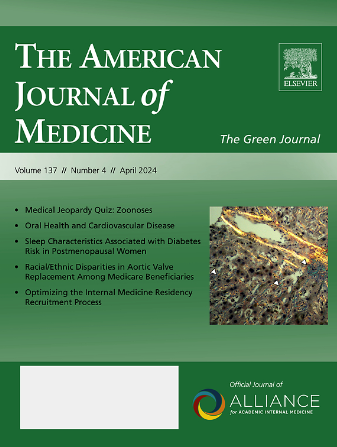通过慢节奏呼吸调节长 COVID 医护人员的心率变异性:一项病例对照研究
IF 2.5
3区 医学
Q1 MEDICINE, GENERAL & INTERNAL
引用次数: 0
摘要
本文章由计算机程序翻译,如有差异,请以英文原文为准。
Heart Rate Variability Modulation Through Slow-Paced Breathing in Health Care Workers with Long COVID: A Case-Control Study
Background
Long COVID is a syndrome persisting 12+ weeks after COVID-19 infection, impacting life and work ability. Autonomic nervous system imbalance has been hypothesized as the cause. This study aims to investigate cardiovascular autonomic function in health care workers (HCWs) with Long COVID and the effectiveness of slow-paced breathing (SPB) on autonomic modulation.
Methods
From December 1, 2022 to March 31, 2023, 6655 HCWs of the University Hospitals of Trieste (Northeast Italy) were asked to participate in the study by company-email. Inclusion/exclusion criteria were assessed. Global health status and psychosomatic disorders were evaluated through validated questionnaires. Heart rate variability was assessed by finger-photoplethysmography during spontaneous breathing and SPB, which stimulate vagal response. Long COVID HCWs (G1) were contrasted with Never infected (G2) and Fully recovered COVID-19 workers (G3).
Results
There were 126 HCWs evaluated. The 58 Long COVID were assessed at a median time because COVID-19 of 419.5 days (interquartile range 269-730) and had significantly more psychosomatic symptoms and lower detectability of spontaneous systolic pressure oscillation at 0.1 Hz (Mayer wave - baroreflex arc) during spontaneous breathing compared with 53 never-infected and 14 fully-recovered HCWs (19%, 42%, and 40%, respectively, P = .027). During SPB, the increase in this parameter was close to controls (91.2%, 100%, and 100%, respectively, P = .09). No other differences in heart rate variability parameters were found among groups.
Conclusions
Resting vascular modulation was reduced in Long COVID, while during SPB, baroreflex sensitivity effectively improved. Long-term studies are needed to evaluate whether multiple sessions of breathing exercises can restore basal vascular reactivity and reduce cardiovascular risk in these patients.
求助全文
通过发布文献求助,成功后即可免费获取论文全文。
去求助
来源期刊

American Journal of Medicine
医学-医学:内科
CiteScore
6.30
自引率
3.40%
发文量
449
审稿时长
9 days
期刊介绍:
The American Journal of Medicine - "The Green Journal" - publishes original clinical research of interest to physicians in internal medicine, both in academia and community-based practice. AJM is the official journal of the Alliance for Academic Internal Medicine, a prestigious group comprising internal medicine department chairs at more than 125 medical schools across the U.S. Each issue carries useful reviews as well as seminal articles of immediate interest to the practicing physician, including peer-reviewed, original scientific studies that have direct clinical significance and position papers on health care issues, medical education, and public policy.
 求助内容:
求助内容: 应助结果提醒方式:
应助结果提醒方式:


